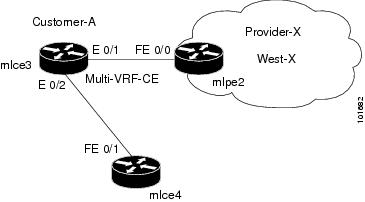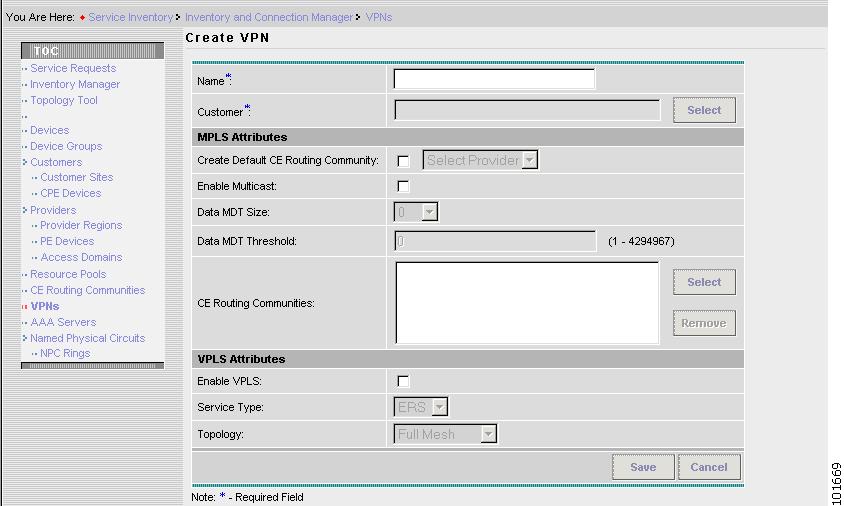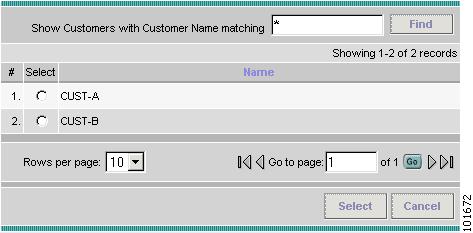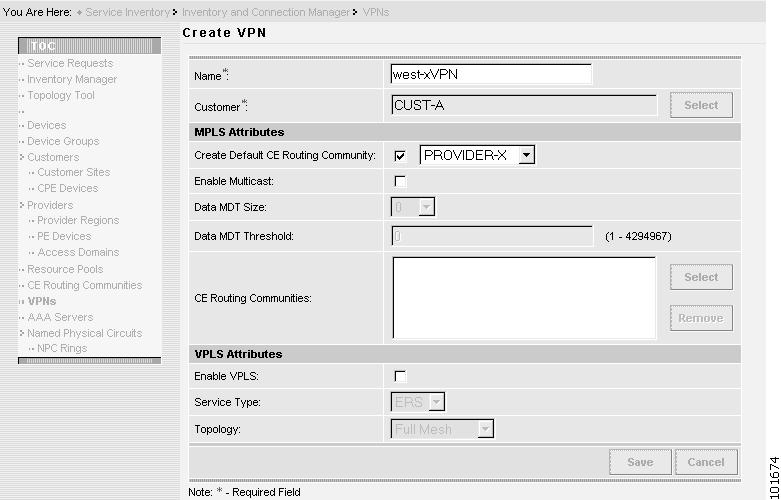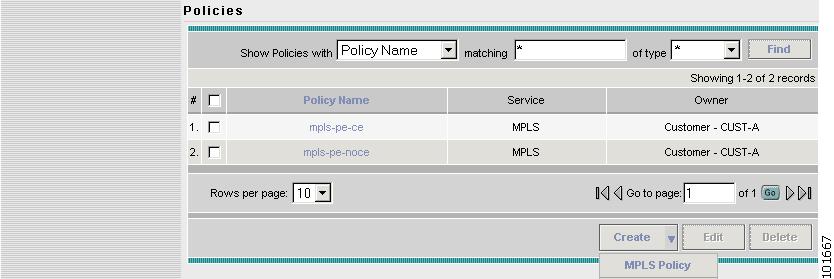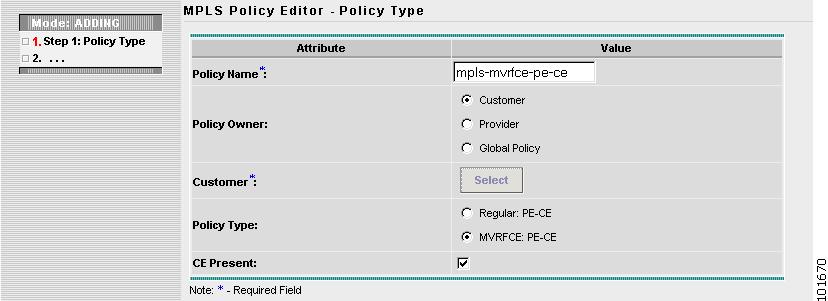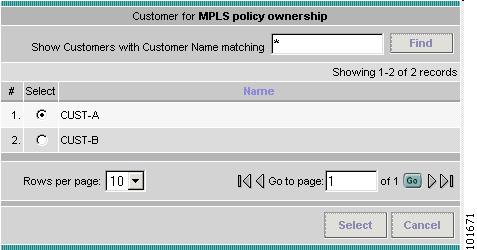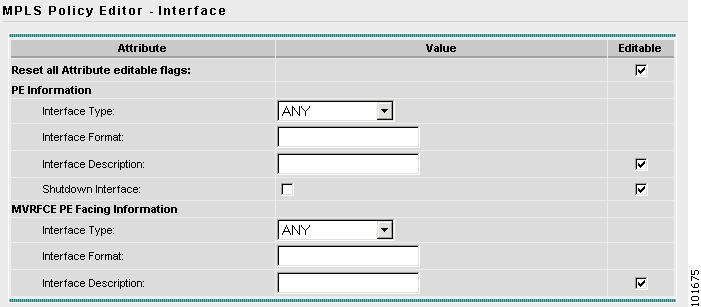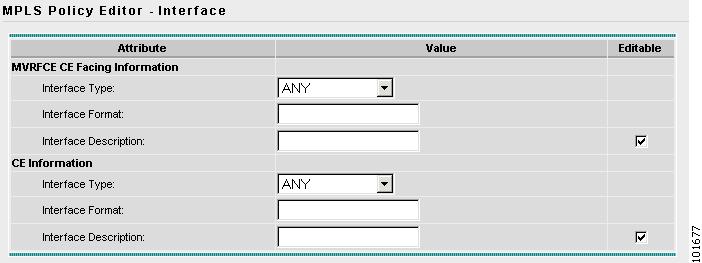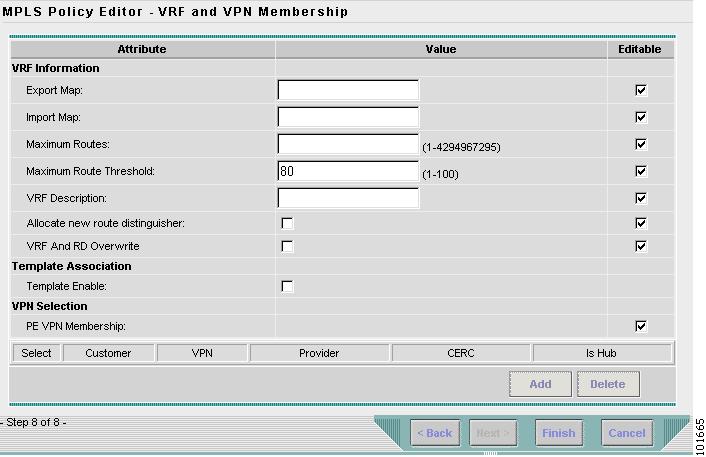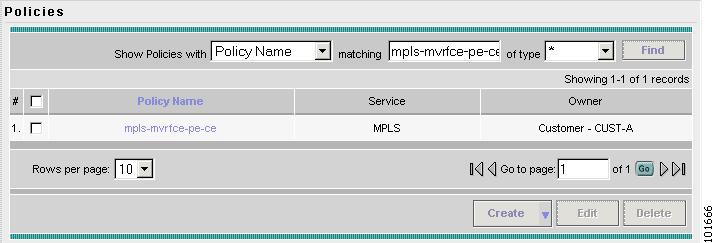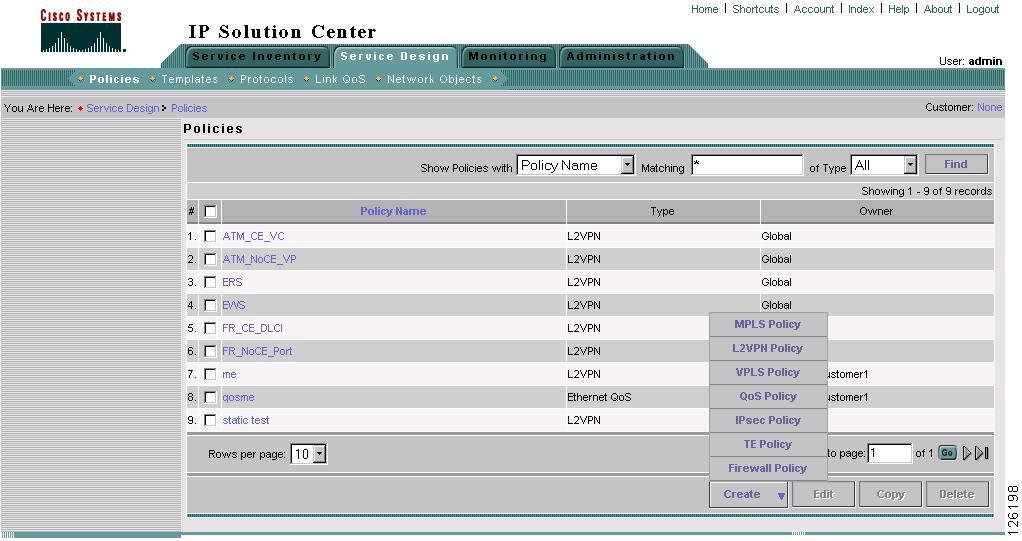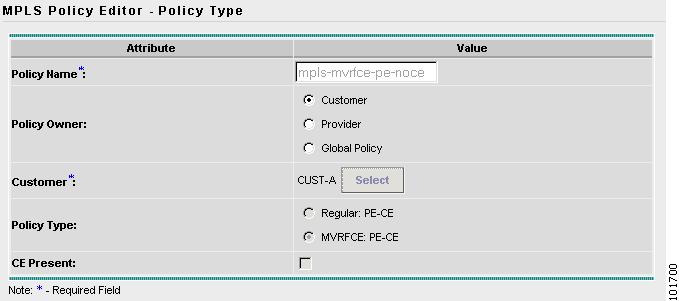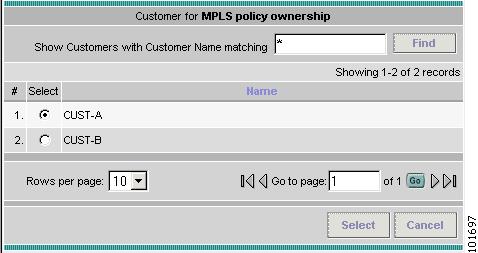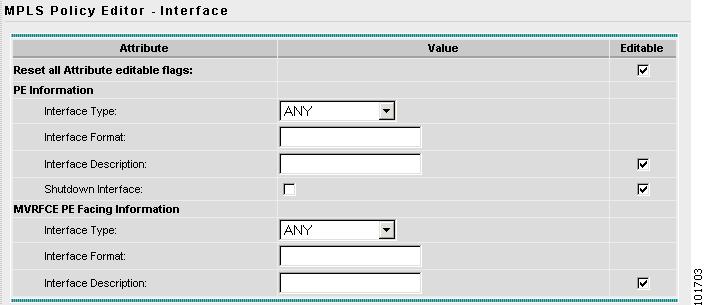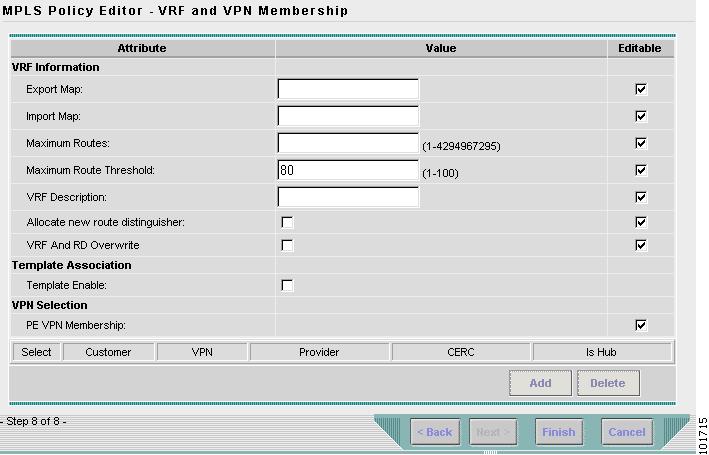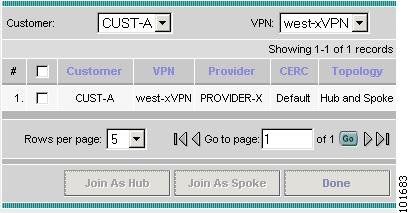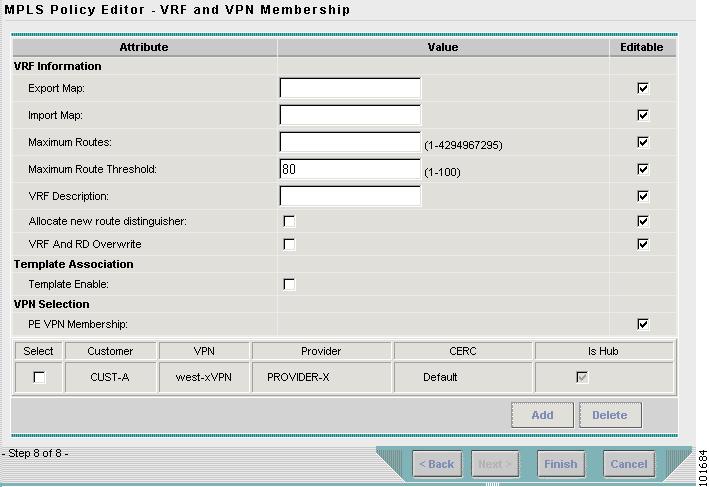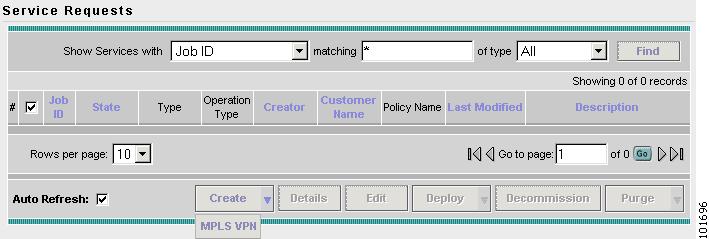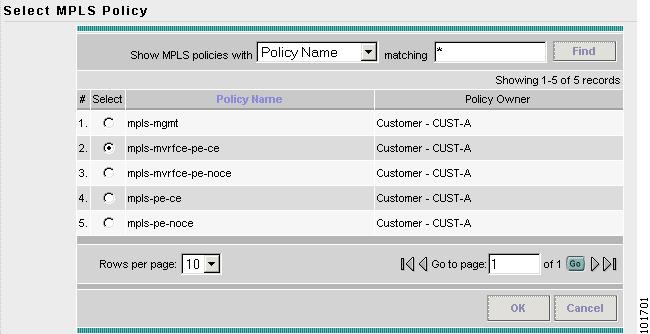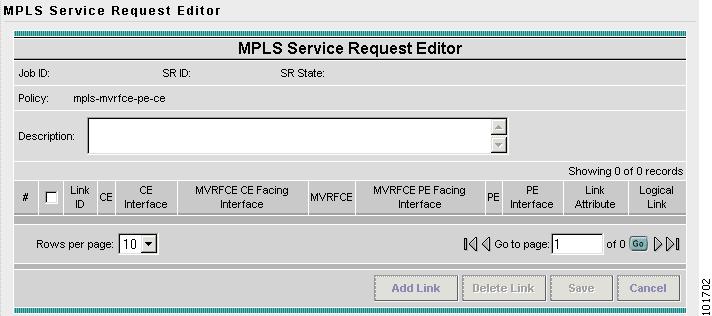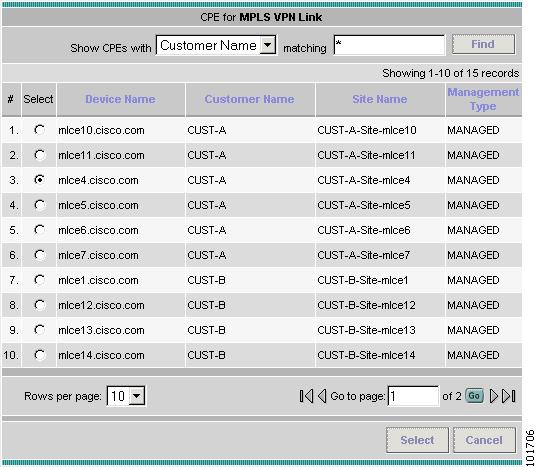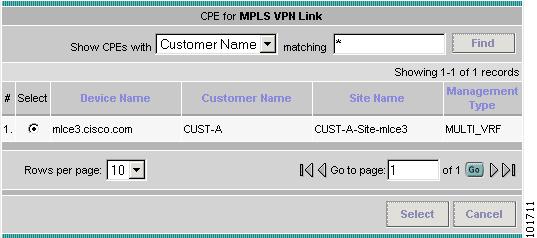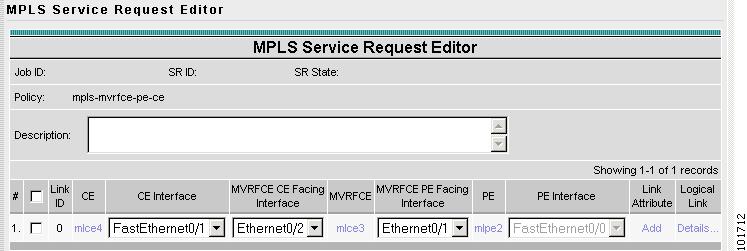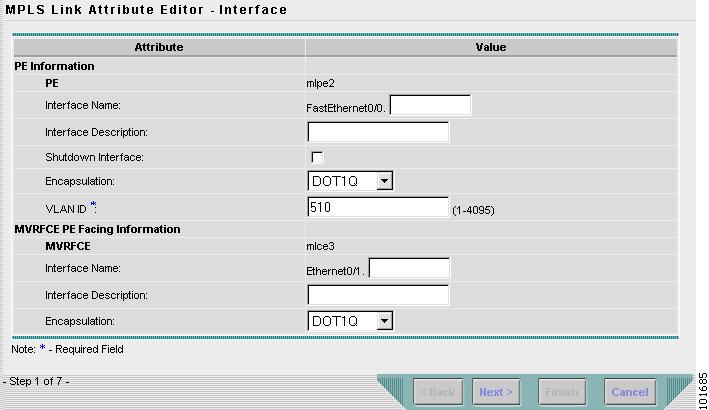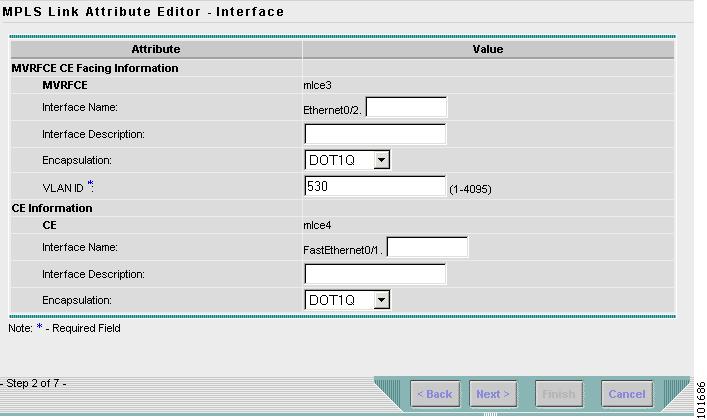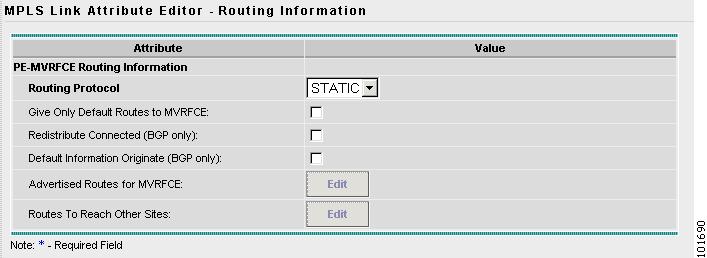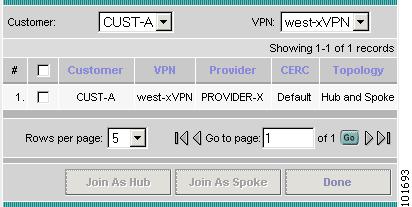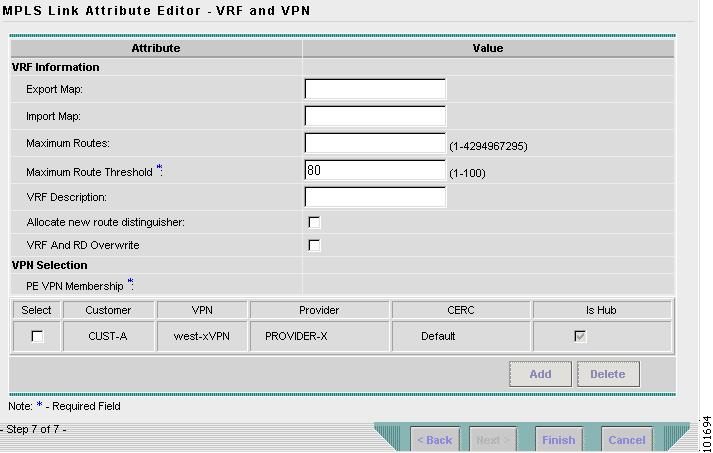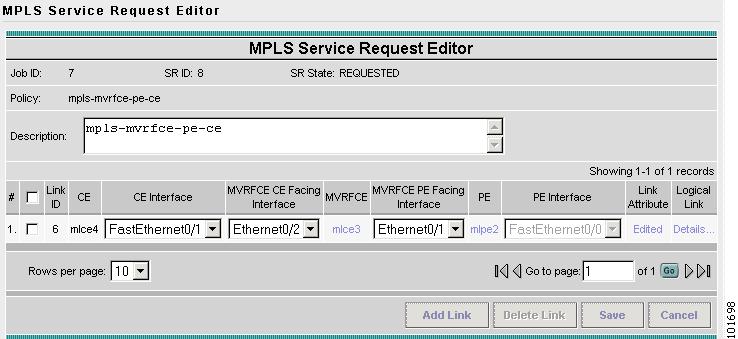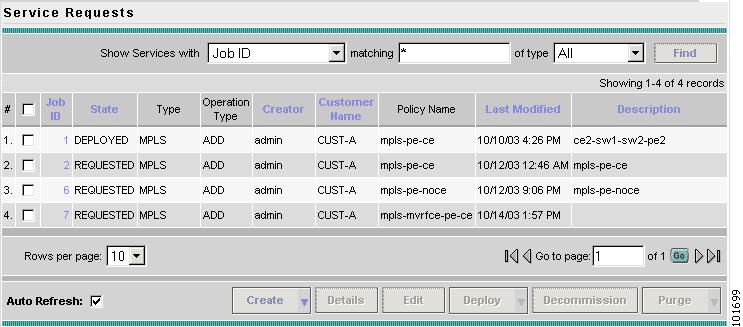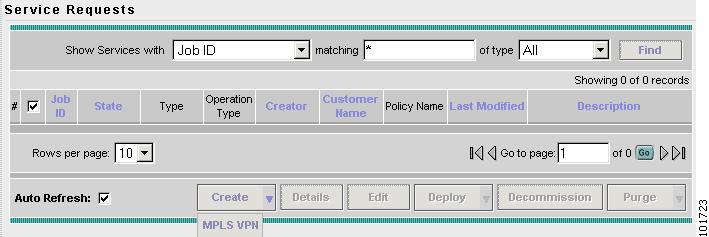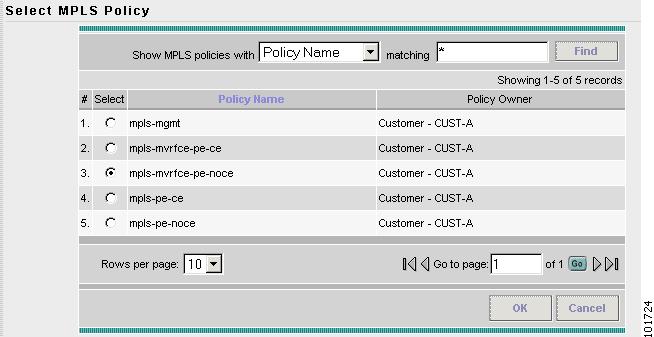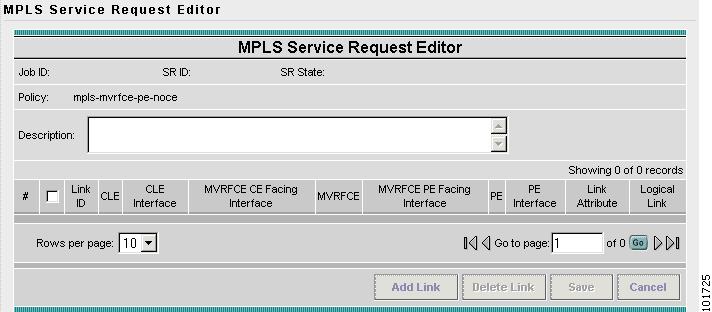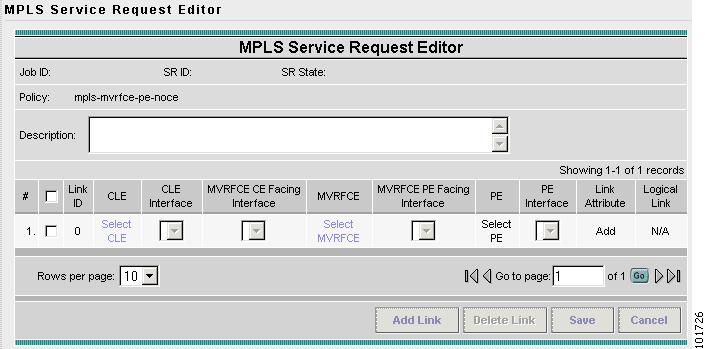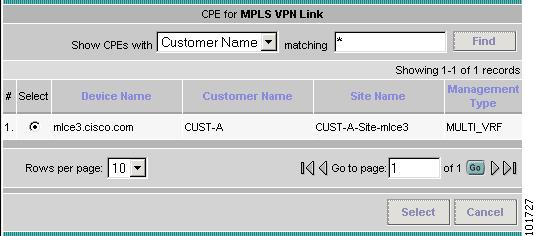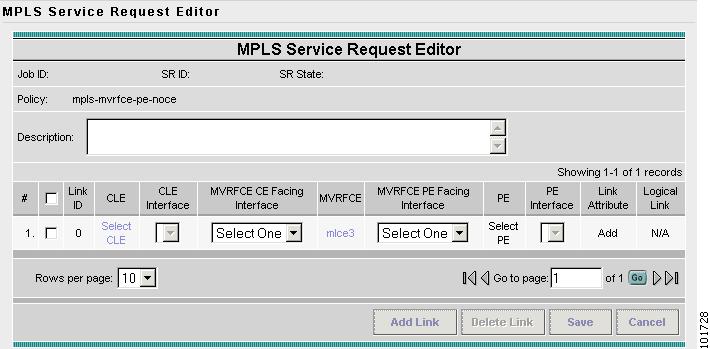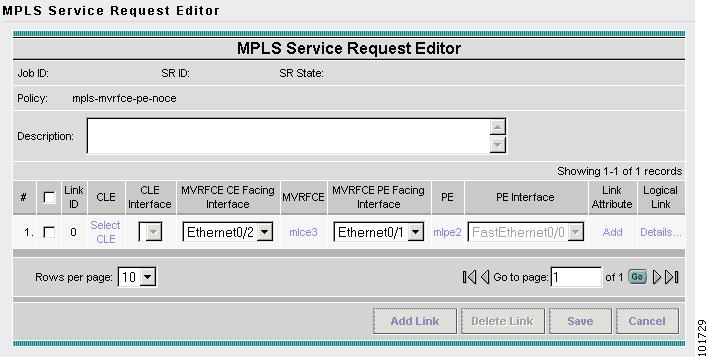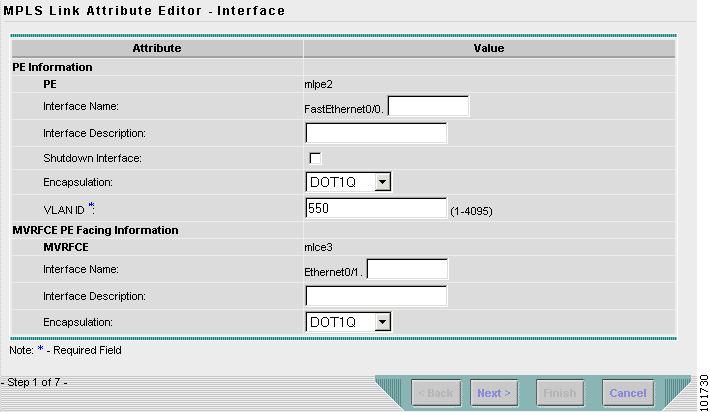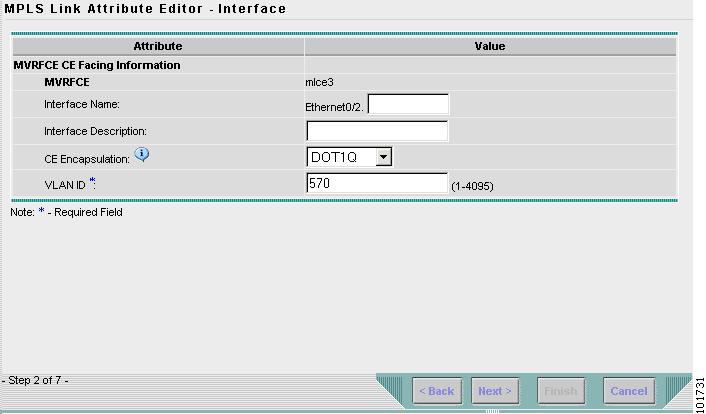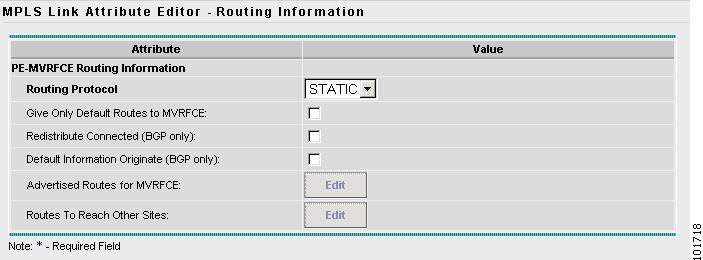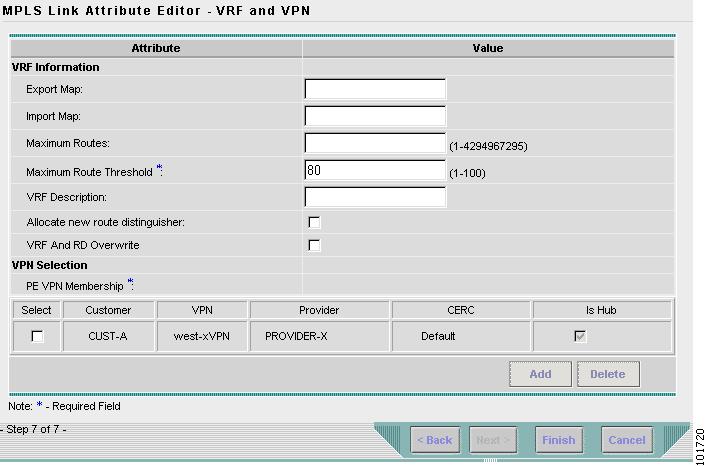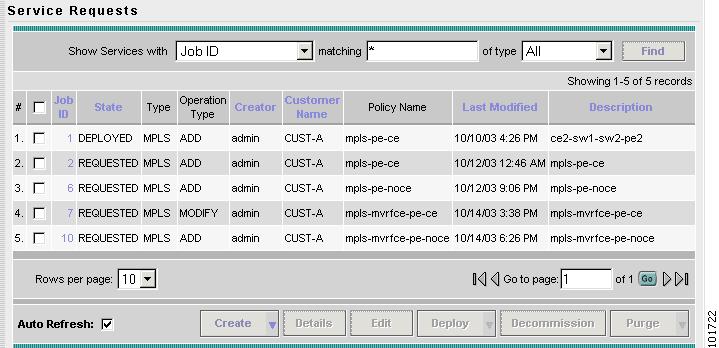

-
Cisco IP Solution Center MPLS VPN User Guide, 4.1
-
Index
-
Preface
-
Getting Started
-
Provisioning Unmanaged Multi-VRF CE
-
Creating Resource Pools
-
Defining VPNs and CERCs
-
MPLS VPN Service Policies
-
MPLS VPN Service Requests
-
Provisioning Regular PE-CE Links
-
Provisioning MVRFCE PE-CE Links
-
Provisioning Management VPN
-
Provisioning Cable Services
-
Provisioning Carrier Supporting Carrier
-
Provisioning Multiple Devices
-
Spanning Multiple Autonomous Systems
-
Creating Custom MPLS Reports
-
IP Solution Center - MPLS VPN
-
Service Request Transition States
-
Troubleshooting MPLS VPN
-
Table Of Contents
Provisioning MVRFCE PE-CE Links
MPLS VPN MVRFCE PE-CE Link Overview
Defining a VPN for the MVRFCE PE-CE Link
Creating MPLS VPN MVRFCE PE-CE Service Policies
Creating a MVRFCE PE-CE Service Policy
Creating a PE-NoCE Service Policy
Creating MPLS VPN MVRFCE PE-CE Service Requests
Creating a MVRFCE PE-CE Service Request
Creating a MVRFCE PE-NoCE Service Request
Provisioning MVRFCE PE-CE Links
This chapter describes how to configure MPLS VPN MVRFCE PE-CE links in the IP Solution Center (ISC) provisioning process. This chapter contains the following major sections:
•
MPLS VPN MVRFCE PE-CE Link Overview
•
Creating MPLS VPN MVRFCE PE-CE Service Policies
•
Creating MPLS VPN MVRFCE PE-CE Service Requests
MPLS VPN MVRFCE PE-CE Link Overview
This section contains the following sections:
To provision an MPLS VPN service in ISC, you must first create an MPLS VPN Service Policy. In ISC, a Service Policy is a set of default configurations for creating and deploying a Service Request.
ISC supports two MPLS VPN Service Policy Types: Regular PE-CE an MVRFCE PE-CE. The following scenarios focus on the MVRFCE PE-CE Policy Type.
An MVRFCE PE-CE Policy Type is a PE to CE link with three devices:
•
PE
•
Multi-VRF CE
•
CE
This Policy Type has two options:
•
CE Present enabled (One PE with one MVRFCE and one CE; three devices)
•
CE Present disabled (One PE with one MVRFCE; two devices)
Figure 8-1 shows an example of an MVRFCE PE-CE link with three devices.
Figure 8-1 MVRFCE PE-CE Link
In an MVRFCE PE-CE link with CE Present enabled, interfaces FE 0/0, E 0/1, E 0/2 and FE 0/1 are configured as an MPLS VPN link in the Service Request process.
Figure 8-2 shows an example of a PE to MVRFCE link with no CE.
Figure 8-2 MVRFCE PE-CE Link with No CE
In an MVRFCE PE-CE link with CE Present disabled, interfaces FE 0/0, E 0/1, and E 0/2 are configured as an MPLS VPN link in the Service Request process.
Network Topology
Figure 8-3 shows an overview of the network topology in which the MPLS VPN MVRFCE PE-CE links are created.
Figure 8-3 Network Topology for MPLS VPN MVRFCE PE-CE Scenarios
The network topology in Figure 8-3 illustrates the lab environment of a service provider (Provider-X) and one customer (Cust-A). There is one Region (West-X) and one PE (mlpe2.cisco.com). Each customer device (one MVRFCE and one CE) represents a Site (mlce3-Site and mlce4-Site).
Prerequisite Tasks
Before you can create a Service Policy in ISC, you must complete the following Inventory Management tasks:
Step 1
Set up a Customer with a Site.
Step 2
Setup a Provider with a Region.
Step 3
Import, create, or discover Devices.
Step 4
Create CPE and PE.
Step 5
Collect Configurations.
Step 6
Create Resource Pools and CE routing communities (CERC).
Step 7
Define a VPN.
Infrastructure Data
In the subsequent MVRFCE PE-CE scenarios, the following infrastructure data is used:
•
Provider: Provider-X
•
Region: West-X
•
AS#: 99
•
PE: mlpe2.cisco.com
•
Device Role: PE POP
•
Customer: Cust-A
•
Site: Cust-A-Site- mlce3
•
CE: mlce3.cisco.com
•
Site: Cust-A-Site- mlce4
•
CE: mlce4.cisco.com
•
Device Role: CPE
•
IP Address Pool:
–
Name: Provider-X-West-X
–
Type: Region
–
Start: 25.7.0.0
–
Mask: 30
–
Size: 16384
•
Route Distinguisher Pool:
–
Name: 99:PROVIDER-X
–
Start: 50000
–
Size: 10000
•
Route Target Pool:
–
Name: 99:PROVIDER-X
–
Start: 50000
–
Size: 10000
•
VPN
–
Definition: west-xVPN
–
See: Defining a VPN for the MVRFCE PE-CE Link
Defining a VPN for the MVRFCE PE-CE Link
During service deployment, ISC generates the Cisco IOS commands to configure the logical VPN relationships.
At the beginning of the provisioning process, before creating a Service Policy, a VPN must be defined within ISC. The first element in a VPN definition is the name of the VPN.
To create a VPN Name, follow these steps:
Step 1
Log in to ISC.
Step 2
Go to Service Inventory > Inventory and Connection Manager > VPNs.
The VPN window appears, as shown in Figure 8-4.
Figure 8-4 VPNs
Step 3
Click Create to create a VPN.
The Create VPN window appears, as shown in Figure 8-5.
Figure 8-5 Create VPN
Step 4
Edit the following attributes:
•
Name: Enter the vpn name. (west-xVPN)
•
Customer: Click Select.
The Select Customer window appears, as shown in Figure 8-6.
Figure 8-6 Choose Customer
Step 5
Choose a customer and click Select.
Step 6
Click Next.
The VPNs window reappears, as shown in Figure 8-7.
Figure 8-7 VPNs
The VPN Name (west-xVPN) is associated with the Customer (Cust-A) in this new VPN definition.
Creating MPLS VPN MVRFCE PE-CE Service Policies
This section contains the following sections:
•
Creating a MVRFCE PE-CE Service Policy
•
Creating a PE-NoCE Service Policy
Creating a MVRFCE PE-CE Service Policy
To create a MVRFCE PE-CE Service Policy, follow these steps:
Step 1
Log in to ISC.
Step 2
Go to Service Design > Policy Manager.
The Policies window appears, as shown in Figure 8-8.
Figure 8-8 Policies
Step 3
From the Create drop-down list, choose MPLS Policy.
The MPLS Policy Editor - Policy Type window appears, as shown in Figure 8-9.
Figure 8-9 MPLS Policy Editor - Policy Type
Step 4
Edit the following attributes:
•
Policy Name: Enter the policy name.
•
Policy Owner: Choose the Policy Owner.
•
Customer: See Step 5.
•
Policy Type: Choose the Policy Type. (Regular MVRFCE PE-CE)
•
CE Present: Choose CE Present. (CE Present)
Step 5
Click Select to specify a Customer.
The Customer for MPLS Policy ownership window appears, as shown in Figure 8-10.
Figure 8-10 Customer for MPLS Policy
Step 6
Choose a Customer and click Select. (Cust-A)
Step 7
Click Next.
The MPLS Policy Editor - PE Interface window appears, as shown in Figure 8-11.
Figure 8-11 The MPLS Policy Editor - PE Interface
Step 8
Click Next.
The MPLS Policy Editor - Interface window appears, as shown in Figure 8-11.
Figure 8-12 The MPLS Policy Editor - CE Interface
Step 9
Click Next to accept the defaults.
Note
Make sure the Editable check boxes are checked, so you can edit these attributes in the Service Request process.
The MPLS Policy Editor - IP Address Scheme window appears, as shown in Figure 8-13.
Figure 8-13 The MPLS Policy Editor - IP Address Scheme
The MPLS Policy Editor - IP Address Scheme window appears, as shown in Figure 8-13.
Figure 8-14 The MPLS Policy Editor - IP Address Scheme
Step 10
Edit the following attributes:
•
IP Numbering Scheme: Choose an IP Numbering Scheme.
•
Automatically Assign IP Address: To have ISC automatically assign IP Addresses, click the check box.
•
IP Address Pool: Choose the IP Address Pool.
Step 11
Click Next.
The MPLS Policy Editor - Routing Information window appears, as shown in Figure 8-15.
Figure 8-15 The MPLS Policy Editor - Routing Information
Step 12
Click Next to accept the defaults.
The MPLS Policy Editor - Routing Information window appears, as shown in Figure 8-16.
Figure 8-16 The MPLS Policy Editor - Routing Information
Step 13
Click Next to accept the defaults.
Note
Make sure the Editable check boxes are checked, so you can edit these attributes in the Service Request process.
The MPLS Policy Editor - VRF and VPN Membership window appears, as shown in Figure 8-17.
Figure 8-17 The MPLS Policy Editor - VRF and VPN Membership
Step 14
Click Next to accept the defaults.
Note
Make sure the Editable check boxes are checked, so you can edit these attributes in the Service Request process.
Step 15
Click Finish.
The Policies window reappears, as shown in Figure 8-18.
Figure 8-18 Policies
The MPLS VPN MVRFCE PE-CE Service Policy is complete.
Creating a PE-NoCE Service Policy
To create a PE-NoCE Service Policy, follow these steps:
Step 1
Log in to ISC.
Step 2
Go to Service Design > Policy Manager.
The Policies window appears, as shown in Figure 8-19.
Figure 8-19 Policies
Step 3
From the Create drop-down list, choose MPLS Policy.
The MPLS Policy Editor - Policy Type window appears, as shown in Figure 8-20.
Figure 8-20 MPLS Policy Editor - Policy Type
Step 4
Edit the following attributes:
•
Policy Name: Enter the policy name.
•
Policy Owner: Choose the Policy Owner.
•
Customer: See Step 5.
•
Policy Type: Choose the Policy Type. (MVRFCE PE-CE)
•
CE Present: Do not choose CE Present.
Step 5
Click Select to specify a Customer.
The Customer for MPLS Policy window appears, as shown in Figure 8-21.
Figure 8-21 Customer for MPLS Policy
Step 6
Choose a customer and click Select.
Step 7
Click Next.
The MPLS Policy Editor - Interface window appears, as shown in Figure 8-22.
Figure 8-22 The MPLS Policy Editor - PE Interface
The MPLS Policy Editor - Interface window appears, as shown in Figure 8-23.
Step 8
Click Next to accept the defaults.
Figure 8-23 The MPLS Policy Editor - CE Interface
Step 9
Click Next to accept the defaults.
Note
Make sure the Editable check boxes are checked, so you can edit these attributes in the Service Request process.
The MPLS Policy Editor - IP Address Scheme window appears, as shown in Figure 8-24.
Figure 8-24 The MPLS Policy Editor - IP Address Scheme
Step 10
Edit the following attributes:
•
IP Numbering Scheme: Choose the IP Numbering Scheme.
•
Automatically Assign IP Address: To have ISC automatically assign IP Addresses, click the check box.
•
IP Address Pool: Choose the IP Address Pool.
•
Click Next.
Step 11
Click Next.
The MPLS Policy Editor - IP Address Scheme window appears, as shown in Figure 8-25.
Figure 8-25 The MPLS Policy Editor - IP Address Scheme
Step 12
Edit the following attributes:
•
IP Numbering Scheme: Choose the IP Numbering Scheme.
•
Automatically Assign IP Address: To have ISC automatically assign IP Addresses, click the check box.
•
IP Address Pool: Choose the IP Address Pool.
Click Next.
The MPLS Policy Editor - Routing Information window appears, as shown in Figure 8-26.
Figure 8-26 The MPLS Policy Editor - Routing Information
Step 13
Click Next to accept the defaults.
The MPLS Policy Editor - Routing Information window appears, as shown in Figure 8-27.
Figure 8-27 The MPLS Policy Editor - Routing Information
Click Next to accept the defaults.
Note
Make sure the Editable check boxes are checked, so you can edit these attributes in the Service Request process.
The MPLS Policy Editor - VRF and VPN Membership window appears, as shown in Figure 8-28.
Figure 8-28 The MPLS Policy Editor - VRF and VPN Membership
Step 14
To add the VPN definition, choose Add:
The VPN dialog box appears, as shown in Figure 8-29.
Figure 8-29 VPN Dialog Box
Click Join as Hub and then click Done.
The MPLS Policy Editor - VRF and VPN Membership window appears, as shown in Figure 8-30.
Figure 8-30 The MPLS Policy Editor - VRF and VPN Membership
Click Finish.
The Policies window reappears, as shown in Figure 8-31.
Figure 8-31 Policies
The MPLS VPN PE-NoCE Service Policy is complete.
Creating MPLS VPN MVRFCE PE-CE Service Requests
This section contains the following sections:
•
Creating a MVRFCE PE-CE Service Request
•
Creating a MVRFCE PE-NoCE Service Request
Creating a MVRFCE PE-CE Service Request
To create a MVRFCE PE-CE Service Request, follow these steps:
Step 1
Log in to ISC.
Step 2
Go to Service Inventory > Inventory and Connection Manager > Service Requests.
The Service Requests window appears, as shown in Figure 8-32.
Figure 8-32 Service Requests
Step 3
From the Create drop-down list, choose MPLS Policy.
The Select MPLS Policy window appears, as shown in Figure 8-33.
Figure 8-33 Select MPLS Policy
Step 4
Choose the MPLS Policy. (mpls-mvrfce-pe-ce)
Step 5
Click OK.
The MPLS Service Request Editor window appears, as shown in Figure 8-34.
Figure 8-34 MPLS Service Request Editor
Step 6
Click Add Link.
The MPLS Service Request Editor window appears, as shown in Figure 8-35.
Figure 8-35 MPLS Service Request Editor - Select CE
Step 7
Click Select CE.
The CPE for MPLS VPN Link window appears, as shown in Figure 8-36.
Figure 8-36 CPE for MPLS VPN Link
Step 8
Choose the CPE Device and click Select.
The MPLS Service Request Editor window appears, as shown in Figure 8-37.
Figure 8-37 MPLS Service Request Editor - Select MVRFCE
Step 9
Choose the CE Interface from the drop-down box.
Step 10
Click Select MVRFCE.
The MVRFCE for MPLS VPN Link window appears, as shown in Figure 8-38.
Figure 8-38 PE for MPLS VPN Link
Step 11
Choose the MVRFCE and click Select.
The MPLS Service Request Editor window appears, as shown in Figure 8-39.
Figure 8-39 MPLS Service Request Editor - Select MVRFCE CE Facing Interface
Step 12
Choose the MVRFCE CE Facing Interface from the drop-down box.
Step 13
Choose the MVRFCE PE Facing Interface from the drop-down box.
The MPLS Service Request Editor window appears, as shown in Figure 8-40.
Figure 8-40 PE for MPLS VPN Link
Step 14
Click Add in the Link Attribute cell.
The MPLS Link Attribute Editor - Interface window appears, as shown in Figure 8-41.
Figure 8-41 MPLS Link Attribute Editor - Interface
PE Information
Step 15
Encapsulation: Choose the PE Encapsulation from the drop-down box. (DOT1Q)
Step 16
VLAN ID: Enter the PE VLAN ID. (510)
MVRFCE PE Facing Information
Step 17
Encapsulation: Choose the PE Encapsulation from the drop-down box. (DOT1Q))
Step 18
Click Next.
The MPLS Link Attribute Editor - Interface window appears, as shown in Figure 8-42.
Figure 8-42 MPLS Link Attribute Editor - Interface
MVRFCE CE Information
Step 19
Encapsulation: Choose the PE Encapsulation from the drop-down box. (DOT1Q)
Step 20
VLAN ID: Enter the PE VLAN ID. (530)
MVRFCE PE Facing Information
Step 21
Encapsulation: Choose the PE Encapsulation from the drop-down box. (DOT1Q)
Click Next.
The MPLS Link Attribute Editor - IP Address Scheme window appears, as shown in Figure 8-43.
Figure 8-43 MPLS Link Attribute Editor - IP Address Scheme
Step 22
Accept the defaults and click Next.
The MPLS Link Attribute Editor - IP Address Scheme window appears, as shown in Figure 8-44.
Figure 8-44 MPLS Link Attribute Editor - IP Address Scheme
Accept the defaults and click Next.
The MPLS Link Attribute Editor - Routing Information window reappears, as shown in Figure 8-45.
Figure 8-45 MPLS Link Attribute Editor - Routing Information
Step 23
Accept the defaults and click Next.
The MPLS Link Attribute Editor - Routing Information window reappears, as shown in Figure 8-46.
Figure 8-46 MPLS Link Attribute Editor - Routing Information
Accept the defaults and click Next.
The MPLS Link Attribute Editor - VRF and VPN window appears, as shown in Figure 8-47.
Figure 8-47 MPLS Link Attribute Editor - VRF and VPN
Step 24
Click Add to join VPN.
The MPLS Link Attribute Editor - VRF and VPN window appears, as shown in Figure 8-48.
Figure 8-48 MPLS Link Attribute Editor - VRF and VPN
Click Add to join VPN.
The MPLS Link Attribute Editor - VRF and VPN window reappears, as shown in Figure 8-49.
Figure 8-49 MPLS Service Request Editor
Step 25
Click Finish.
The MPLS Service Request Editor window reappears, as shown in Figure 8-50.
Figure 8-50 MPLS Service Request Editor
Step 26
Enter the Service Request description and click Save. (mpls-mvrfce-pe-ce)
The MPLS Service Requests window reappears, as shown in Figure 8-51.
Figure 8-51 Service Request
The MPLS VPN MVRFCE PE-CE Service Request is in the Requested state and ready to deploy.
Creating a MVRFCE PE-NoCE Service Request
To create a MVRFCE PE-NoCE Service Request, follow these steps:
Step 1
Log in to ISC.
Step 2
Go to Service Inventory > Inventory and Connection Manager > Service Requests.
The Service Requests window appears, as shown in Figure 8-52.
Figure 8-52 Service Requests
Step 3
From the Create drop-down list, choose MPLS VPN.
The Select MPLS Policy window appears, as shown in Figure 8-53.
Figure 8-53 Select MPLS Policy
Step 4
Choose the MPLS Policy. (mpls-mvrfce-pe-noce)
Step 5
Click OK.
The MPLS Service Request Editor window appears, as shown in Figure 8-54.
Figure 8-54 MPLS Service Request Editor
Step 6
Click Add Link.
The MPLS Service Request Editor window appears, as shown in Figure 8-55.
Figure 8-55 MPLS Service Request Editor - Select MVRFCE
Step 7
Click Select MVRFCE.
The CPE for MPLS VPN Link window appears, as shown in Figure 8-56.
Figure 8-56 CPE for MPLS VPN Link
Step 8
Choose the MVRFCE and click Select.
The MPLS Service Request Editor window appears, as shown in Figure 8-57.
Step 9
Click Select MVRFCE.
Figure 8-57 MPLS Service Request Editor - MVRFCE CE Facing Interface
Step 10
Choose the MVRFCE CE Facing Interface from the drop-down box.
Step 11
Choose the MVRFCE PE Facing Interface from the drop-down box.
The MPLS Service Request Editor window appears, as shown in Figure 8-58.
Figure 8-58 MPLS Service Request Editor
Step 12
Click Add in the Link Attribute cell.
The MPLS Link Attribute Editor - Interface window appears, as shown in Figure 8-59.
Figure 8-59 MPLS Link Attribute Editor - Interface
PE Information
Step 13
Encapsulation: Choose the PE Encapsulation from the drop-down box. (DOT1Q)
Step 14
VLAN ID: Enter the PE VLAN ID. (550)
MVRFCE PE Facing Information
Step 15
Encapsulation: Choose the PE Encapsulation from the drop-down box. (DOT1Q))
Step 16
Click Next.
The MPLS Link Attribute Editor - Interface window appears, as shown in Figure 8-60.
Figure 8-60 MPLS Link Attribute Editor - Interface
MVRFCE CE Information
Step 17
Encapsulation: Choose the PE Encapsulation from the drop-down box. (DOT1Q)
Step 18
VLAN ID: Enter the PE VLAN ID. (570)
MVRFCE PE Facing Information
Step 19
Encapsulation: Choose the PE Encapsulation from the drop-down box. (DOT1Q)
Click Next.
The MPLS Link Attribute Editor - IP Address Scheme window appears, as shown in Figure 8-61.
Figure 8-61 MPLS Link Attribute Editor - IP Address Scheme
Step 20
Accept the defaults and click Next.
The MPLS Link Attribute Editor - IP Address Scheme window appears, as shown in Figure 8-62.
Figure 8-62 MPLS Link Attribute Editor - IP Address Scheme
Accept the defaults and click Next.
The MPLS Link Attribute Editor - Routing Information window reappears, as shown in Figure 8-63.
Figure 8-63 MPLS Link Attribute Editor - Routing Information
Step 21
Accept the defaults and click Next.
The MPLS Link Attribute Editor - Routing Information window reappears, as shown in Figure 8-64.
Figure 8-64 MPLS Link Attribute Editor - Routing Information
Accept the defaults and click Next.
The MPLS Link Attribute Editor - VRF and VPN window appears, as shown in Figure 8-65.
Figure 8-65 MPLS Link Attribute Editor - VRF and VPN
Step 22
Click Add to join VPN.
Step 23
Click Finish.
The MPLS Service Request Editor window reappears, as shown in Figure 8-66.
Figure 8-66 MPLS Service Request Editor
Step 24
Enter the Service Request description and click Save. (mpls-mvrfce-pe-noce)
The MPLS Service Requests window reappears, as shown in Figure 8-67.
Figure 8-67 Service Request
The MPLS VPN MVRFCE PE-NoCE Service Request is in the Requested state and ready to deploy.

 Feedback
Feedback

